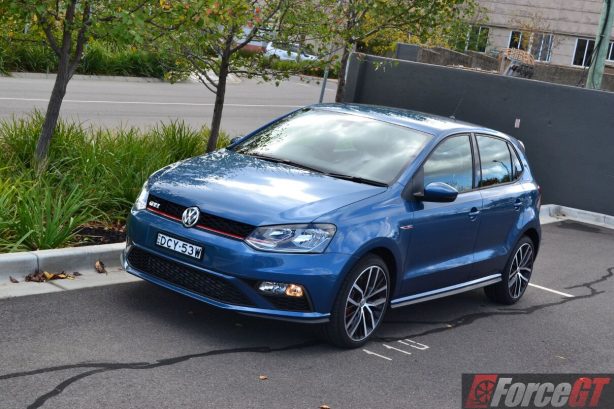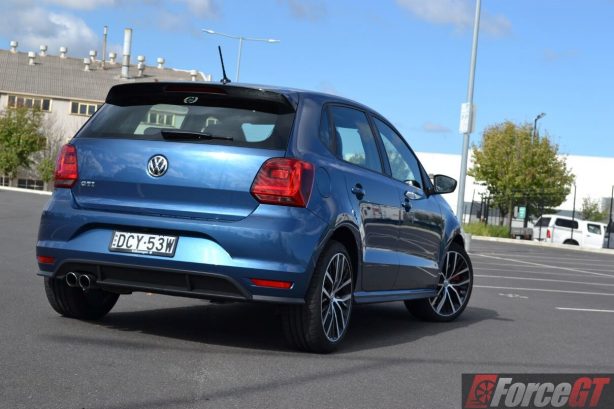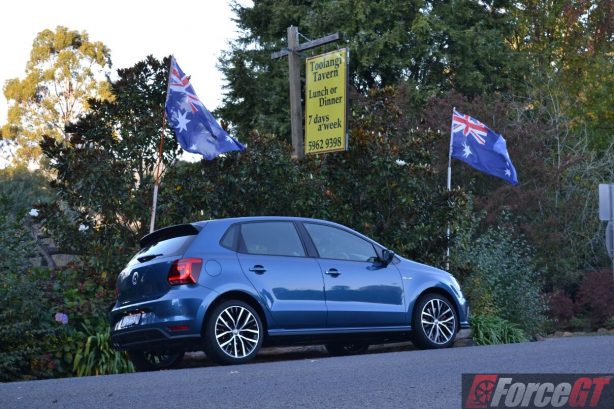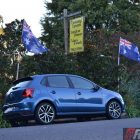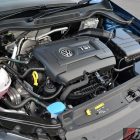If you have just graduated from go-karts academy, or progressed from Gran Turismo to the real world, chances are you will be looking at one of these: Toyota 86, Mazda MX-5, Subaru BRZ, Ford Fiesta, Honda CR-Z, Peugeot 308 GTi, Hyundai Veloster Turbo, Kia Pro_Cee’d GT, Abarth 595, Renault Clio R.S., Volkswagen Polo GTI …
Yup, your options are endless. But if you’re having a hard time tossing between more power or more comfort, sportier looks or better interior, there’s that one car from the list that offers a bit of everything – the Volkswagen Polo GTI.
Priced from $27,490 plus on-road costs, the revised 2016 range finally gets the long-awaited manual transmission. Compared to its rivals, the Polo GTI is $1,500 more expensive than the Fiesta ST, but $2,500 cheaper than the 208 GTi – both manual only. It also undercuts the twin-clutch-only Clio R.S 200 by $2,000.
Those who find a DIY box too taxing can still opt for the $29,990 seven-speed twin-clutch DSG Polo GTI. But, trust me, the three-pedal Polo GTI tested here is way more fun. Sadly, the three-door model has been dropped from the Australian lineup.
Subtle changes to the 2016 Polo GTI include a new front bumper featuring fog lights with static cornering function mounted in the lower bumper. The iconic red grille now continues into the headlight housing like the Golf GTI.
In profile, the facelifted model gets a ‘GTI’ badge on the front fender, unique side sills and 17-inch ‘Parabolica’ alloy wheels behind which hide red brake calipers.
The biggest headline however, is the new 1.8-litre turbocharged four-cylinder petrol engine (related to the 2.0-litre engines in the Golf GTI and Golf R) that produces 141kW of power, up 9kW from the previous 1.4-litre turbocharged and supercharged four-cylinder.
Its torque figure varies based on the transmission. When paired with the manual, it delivers a muscular 320Nm of torque, but drops to 250Nm when mated with the DSG.
The engine delivers power to the front wheels in silky linearity and benchmark refinement with hardly any turbo lag. With a thick midrange that rushes in from just 1450rpm, it feels properly quick, too. It also likes to revs and the pull now continues past 5000rpm.
Despite the torque difference, Volkswagen claims both the auto and manual versions are capable of dashing from 0-100km/h in 6.7 seconds, 0.2 seconds quicker than the old model.
Shuffled by six perfectly spaced ratio, the manual Polo GTI is as much fun in twisty back roads as it is satisfying to take to the shops.
Sitting on sports suspension that’s lower than the regular Polo (by 10mm at the front and 15mm at the rear), the GTI is predictable and stable on the limit, with crisp direction changes and abundance of grip.
However, the chassis offers little in the way of engagement you expect from a hot hatch. You never feel the baby GTI holding it all together and in unison with you around the bends, despite the addition of adaptive dampers in this new model.
Like the chassis, the new electromechanical steering isn’t as communicative as we’d hope but points precisely. Elsewhere, the all-round disc brakes shed speed with good bite and progression.
Swapping cogs with the manual gearbox is swift and slick but enthusiasts may find it overly light and easy.
The flip side for the slightly lukewarm approach to driving fun is perhaps the Polo GTI’s sensibility and practicality for everyday use. The cabin is well damped from outside noises and the drivetrain is suitably relaxed when left ticking along at high gears.
Four average-sized adults would fit nicely in the cabin (five is too squashy) and the ride around town is decent (for hot hatch standard). The boot opens up to 204 litres of storage, or a sizeable 882 litres with the rear seats folded.
On paper, the manual transmission is rated at 6.1L/100km, while the DSG is claimed to return 5.7L/100km. In our real world test covering over 500km of mixed driving, we managed 7.7L/100km, which is not far off the rated figure but the Peugeot 208 GTi is more efficient.
The interior is built to the typical high standard of Volkswagen with class-leading clarity and material quality. It inherits many of the Mk 7 Golf GTI’s features, including the leather wrapped flat-bottom steering wheel with paddle shifters (DSG models), aluminium pedals and a 6.5-inch Composition Media touchscreen infotainment system which is still the best in class and now supports Apple CarPlay and Android Auto.
The car also gets engine stop-start and auto emergency braking system as standard. Beyond this, the available options are pricey.
Two optional packages add a host of convenience and assistance systems. The $1,700 Driver Assistance Package brings the Discover Media Infotainment system with satellite navigation, a reversing camera, front and rear parking sensors and driver fatigue detection system.
The $3,300 Luxury Package further adds LED headlights with daytime running lights, comfort sport front seats with Alcantara/leather-look upholstery and a panoramic electric glass sunroof.
Verdict
Design and Comfort: 8.0/10
Performance and Handling: 7.5/10
Quality: 8.5/10
Economy: 7.5/10
Equipment and Features: 7.5/10
The Volkswagen Polo GTI isn’t the fastest, loudest or most exciting among the slew of entry-level performance cars on the market today, but it is the most all-rounded. If you’re looking for a four-door hatch with a bit of poke and a good blend of sportiness, comfort and quality, the baby GTI fits the bill perfectly.
But, for an out-and-out hot hatch with scintillating performance and unrestrained engagement, you’ll need to look at the Peugeot 208 GTi or Renault Clio R.S. (Or try one of the 86 / MX-5 / BRZ rear-wheel drive fun machines).
Pros
- Punchy engine
- Benchmark build quality
- Everyday usability
- Up to date features and connectivity
Cons
- Rivals are cheaper and more fun to drive
- Too grown up?
2016 Volkswagen Polo GTI pricing and specification
| Price (excluding on-roads): | From $27,490 / As tested: $27,990* *includes: · Metallic paint – $500 |
| Warranty: | 3 years/unlimited km |
| Warranty Customer Assistance: | 1 year roadside |
| Service Intervals: | 12 months/15,000km |
| Engine: | 1.8-litre turbocharged four-cylinder petrol: 141kW @ 6,200rpm, 320Nm @ 4,200rpm |
| Transmission: | 6-speed manual / 7-speed DSG twin-clutch automatic |
| Drivetrain: | Front-wheel drive |
| Power-to-Weight Ratio (W/kg): | 114.3 |
| 0-100km/h (seconds): | Claimed: 6.7 / Tested: 7.0 |
| Combined Fuel Consumption (L/100km): | Manual – Claimed: 6.1 / Tested: 7.7 Auto – Claimed: 5.7 |
| Ron Rating: | 95 Premium ULP |
| Fuel Capacity (L): | 45 |
| Body: | Four-door hatchback, 5 seats |
| Safety: | 5 star ANCAP, 6 airbags, ABS, EBD, BA, VSC, Hill-start Assist Control, tyre pressure monitor, parking sensors, auto emergency braking |
| Dimensions (L/W/H/W-B) mm: | 3,983/1,682/1,443/2,470 |
| Kerb Weight (kg): | 1,234 |
| Entertainment: | 6.5-inch touchscreen display, Apple Carplay, Android Auto, 6-speaker, Bluetooth, USB and AUX |
Competitors: Toyota 86, Mazda MX-5, Subaru BRZ, Ford Fiesta, Honda CR-Z, Peugeot 208 GTi, Hyundai Veloster Turbo, Kia Pro_Cee’d GT, Abarth 595, Renault Clio R.S., Alfa Romeo MiTo QV
 ForceGT.com Car News, Car Reviews, Video Reviews, Tuning and much more.
ForceGT.com Car News, Car Reviews, Video Reviews, Tuning and much more. 